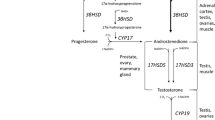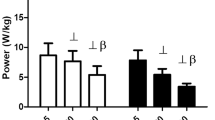Summary
Changes in the testosterone concentrations after single sessions of endurance and strength training were measured in seven well trained men, experienced in both forms of training. Both training sessions were rated as hard to very hard on the Borg scale. Blood samples for testosterone measurements were taken before, immediately after, and 2, 4 and 6 h after the training sessions as well as the next morning. The mean tes tosterone concentration increased 27% (P<0.02) and 37% (P< 0.02) during the strength and endurance training session, respectively. Two hours after the training sessions the mean testosterone concentration had re turned to the pre-training level and remained at that level for the length of the observation period. There were no significant differences in the changes in testosterone concentration after strength and endurance training but there were large differences in the testosterone response at the level of the individual. A high correlation (r=0.98;P<0.001) for individuals was found between increases in testosterone concentration after strength and after endurance training. It was concluded that the changes in mean testosterone values followed the same timecourse after single sessions of strength and endurance training of the same duration and perceived exertion. The interindividual differences in tes tosterone response may be of importance for individual adaptation to training.
Similar content being viewed by others
References
Booth Å, Shelley G, Mazur Å, Tharp G, Kittok R (1989) Testosterone, and winning and losing in human competition. Horm Behav 23:556–571
Borg GAV (1982) Psychophysical bases of perceived exertion. Med Sci Sports Exerc 14:377–381
Cadoux-Hudson TA, Few DJ, Imms FJ (1985) The effect of exercise on the production and clearance of testosterone in welltrained young men. Eur J Appl Physiol 54:321–325
Costill DL, Fink WJ (1974) Plasma volume changes following exercise and the thermal dehydration. J Appl Physiol 37:521–525
Cumming DC, Wheeler GD, McColl EM (1989) The effects of exercise on reproductive function in men. Sports Med 7:1–17
Fahey TD, Rolph R, Moungmee P, Nagel J, Mortara S (1976) Serum testosterone, body composition, and strength of, young adults. Med Sci Sports 8:31–34
Florini JR (1987) Hormonal control of muscle growth. Muscle Nerve 10:577–598
Galbo H, Hummer L, Petersen IB, Christensen NJ, Bie N (1977) Thyroid and testicular hormone responses to graded and prolonged exercise in man. Eur J Appl Physiol 36:101–106
Guezennec Y, Leger L, Lhoste F, Aymonod M, Pesquies PC (1986) Hormone and metabolite response to weight-lifting training sessions. Int J Sports Med 7:100–105
Guglielmini C, Paolini AR, Conconi FR (1984) Variations of serum testosterone concentrations after physical exercises of different duration. Int J Sports Med 5:246–249
Gustafsson J-Å, Pousette Å (1975) Demonstration and partial characterization of cytosol receptors for testosterone. Biochemistry 14:3094–3101
Hackney AC (1989) Endurance training and testosterone levels. Sports Med 8:117–127
Hakkinen K, Pakarinen Å, Alén M, Kauhanen H, Komi PV (1988a) Neuromuscular and hormonal adaptations in athletes to strength training in two years. J Appl Physiol 65:2406–2412
Häkkinen K, Pakarinen Å, Alén M, Kauhanen H, Komi PV (1988b) Neuromuscular and hormonal responses in elite athletes to two successive strength training sessions in one day. Eur J Appl Physiol 57:133–139
Henriksson J, Reitman JS (1976) Quantitative measures of enzyme activities in type I and type II muscle fibres of man after training. Acta Physiol Scand 97:392–397
Howald H, Hoppeler H, Claassen H, Mathieu O, Straub R (1985) Influences of endurance training on the ultrastructural composition of the different muscle fiber types in humans. Pflügers Arch 403:369–376
Ingjer F (1979) Effects of endurance training on muscle fibre ATP-ase activity, capillary supply and mitochondrial content in man. J Physiol 294:419–432
Kindermann W, Schmitt WM, Schnabel Å, Berg Å, Biro G (1985) Verhalten von Testosteron im Blutserum bei Körperarbeit unterschiedlicher Dauer und Intensitdt. Dtsch Z Sportmed 36:99–104
Kjær M, Secher NH, Bach FW, Galbo H (1987) Role of motor center activity for hormonal changes and substrate mobilization in humans. Am J Physiol 253: R687-R695
Kraemer WJ (1988) Endocrine responses to resistance exercise. Med Sci Sports Exerc 20:S152-S157
Kuoppasalmi K (1980) Plasma testosterone and sex-hormonebinding globulin capacity in physical exercise. Scand J Clin Lab Invest 40:411–418
Kuoppasalmi K, Näveri H, Rehunen S, Härkönen M, Adlercreutz H (1976) Effect of strenuous anaerobic running exercise on plasma growth hormone, cortisol, luteinizing hormone, testosterone, androstenedione, estrone and estradiol. J Steroid Biochem 7:823–829
MacConnie SE, Barkan A, Lampman RM, Schork MA, Beitins IZ (1986) Decreased hypothalamic gonadotropin-releasing hormone secretion in male marathon runners. N Engl J Med 315:411–417
McDonagh MJN, Davies CTM (1984) Adaptive response of mammalian skeletal muscle to exercise with high loads. Eur J Appl Physiol 52:139–155
Métivier G, Gauthier R, de la Chevrotiére J, Grymala D (1980) The effect of acute exercise on the serum levels of testosterone and luteinizing (LH) hormone in human male athletes. J Sports Med Phys Fitness 20:235–238
Snochowski M, Dahlberg E, Gustafsson J-Å (1980) Characterization and quantification of the androgen and glucocorticoid receptors in cytosol from rat skeletal muscle. Eur J Biochem 111:603–616
Urhausen A, Kullmer T, Kindermann W (1987) A 7-week followup study of the behaviour of testosterone and cortisol during the competition period in rowers. Eur J Appl Physiol 56:528–533
Webb ML, Wallace JP, Hamill C, Hodgson JL, Mashaly MM (1984) Serum testosterone concentration during two hours of moderate intensity treadmill running in trained men and women. Endocr Res 10:27–38
Weiss LW, Cureton KJ, Thompson FN (1983) Comparison of serum testosterone and androstenedione responses to weight lifting in man and women. Eur J Appl Physiol 50:413–419
Wilkerson JE, Horvath SM, Gutin B (1980) Plasma testosterone during treadmill exercise. J Appl Physiol 49:249–253
Author information
Authors and Affiliations
Rights and permissions
About this article
Cite this article
Jensen, J., Oftebro, H., Breigan, B. et al. Comparison of changes in testosterone concentrations after strength and endurance exercise in well trained men. Europ. J. Appl. Physiol. 63, 467–471 (1991). https://doi.org/10.1007/BF00868080
Accepted:
Issue Date:
DOI: https://doi.org/10.1007/BF00868080




